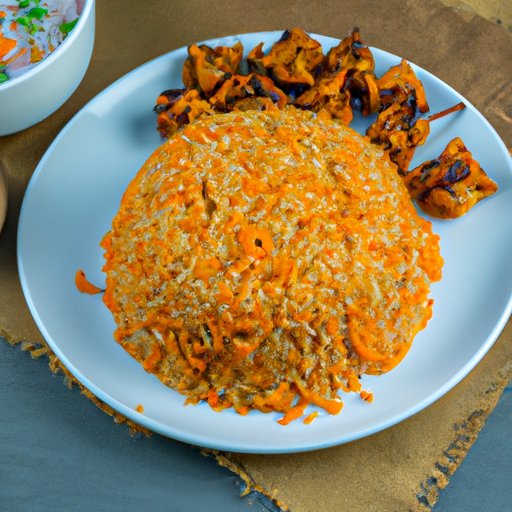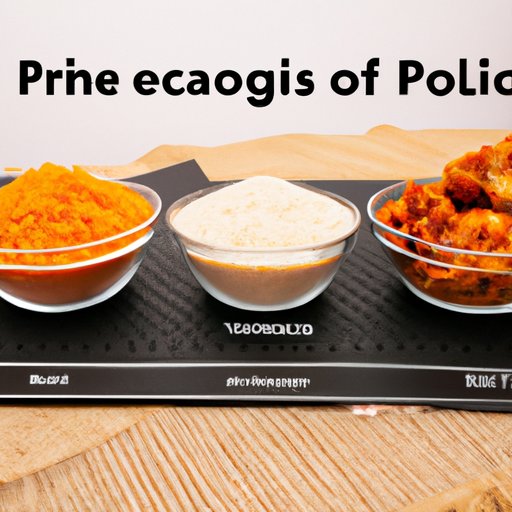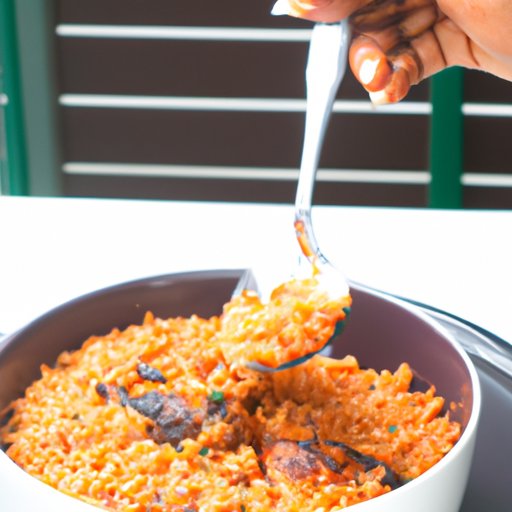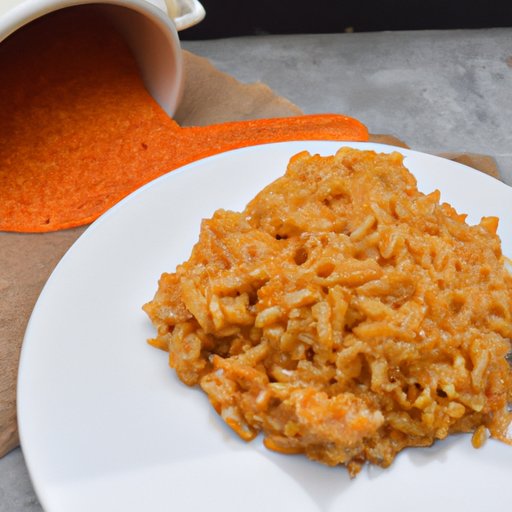Introduction
Jollof rice is a traditional West African dish that is known for its unique flavor and vibrant color. It is made with long-grain rice, tomatoes, tomato paste, onions, garlic, ginger, chili peppers, and various seasonings and spices. It is typically served with a variety of meats, vegetables, and side dishes.
In recent years, there has been an increasing interest in exploring the health benefits and risks associated with eating jollof rice. While this dish is often thought of as a nutritious and flavorful meal, there are some potential health concerns that should be taken into consideration before adding it to your diet. In this article, we will take a closer look at the nutritional content of jollof rice, compare it to other popular dishes, and examine the role it plays in African cuisine.

Exploring the Nutritional Benefits of Jollof Rice
When it comes to the nutritional benefits of jollof rice, there are several vitamins and minerals found in this dish that can provide health benefits. The main source of nutrients in jollof rice is the combination of long-grain rice, tomatoes, and other ingredients used to prepare the dish. These ingredients are rich in dietary fiber, iron, magnesium, potassium, zinc, vitamin A, and other essential vitamins and minerals.
The vitamins and minerals found in jollof rice can provide a number of health benefits. For example, the dietary fiber found in jollof rice can help improve digestion and reduce the risk of diabetes and heart disease. Additionally, the iron content of jollof rice helps to keep the body’s red blood cell count healthy and can prevent anemia. Magnesium helps to maintain strong bones and teeth, while potassium can help regulate blood pressure and reduce the risk of stroke. Finally, zinc helps to boost the immune system and can help protect against infections.

The Health Risks Associated with Eating Jollof Rice
While jollof rice does offer a number of nutritional benefits, there are also some potential health risks associated with eating this dish. One of the most significant health risks is the high sodium content found in jollof rice. This is due to the fact that many recipes call for large amounts of salt to be added to the dish. Consuming too much sodium can lead to an increased risk of developing high blood pressure and other cardiovascular diseases.
In addition to the high sodium content, jollof rice is also relatively high in calories. A single serving of jollof rice can contain up to 500 calories, which can add up quickly if you are not careful. Furthermore, there is also the potential risk of food poisoning when consuming jollof rice, as the dish is typically cooked at high temperatures. As such, it is important to ensure that the dish is cooked properly and stored correctly to minimize the risk of foodborne illness.

Comparing the Nutritional Content of Jollof Rice to Other Popular Dishes
When comparing the nutritional content of jollof rice to other popular dishes, it is important to consider the various vitamins and minerals found in each dish. For example, when compared to white rice, jollof rice contains significantly more dietary fiber, iron, magnesium, potassium, and zinc. On the other hand, white rice is higher in carbohydrates and contains fewer calories than jollof rice. It is also worth noting that jollof rice contains more protein than both white and brown rice.
When compared to other traditional African dishes, jollof rice still stands out as a healthier option. Dishes such as fufu, akara, and egusi are typically higher in fat and calories than jollof rice. Additionally, these dishes are often served with high-fat sauces or condiments that can further increase their calorie and fat content.
Examining the Role Jollof Rice Plays in African Cuisine
Jollof rice is an important part of African cuisine and has a long and storied history. Originating in West Africa, the dish is believed to have been invented by the Wolof people of Senegal. Over time, the dish spread throughout the continent and is now enjoyed in many countries, including Nigeria, Ghana, Liberia, Sierra Leone, Togo, and Cameroon.
Despite its widespread popularity, jollof rice varies greatly in terms of preparation and ingredients depending on what region it is being prepared in. For example, in Nigeria, jollof rice is typically made with palm oil and a variety of spices, while in Ghana, it is usually prepared with coconut milk and hot pepper. Additionally, the way in which jollof rice is eaten also varies from region to region. In Nigeria, it is often served as the centerpiece of a meal, while in Ghana, it is typically served as a side dish.

Debunking Common Misconceptions About the Healthiness of Jollof Rice
Despite the numerous health benefits associated with eating jollof rice, there are still some misconceptions about the healthiness of the dish. Many people mistakenly believe that jollof rice is unhealthy due to its high fat and calorie content. However, the dish is actually very low in fat and contains fewer calories than many other popular dishes, such as fried rice and pasta.
It is also important to remember that jollof rice can be part of a balanced diet when consumed in moderation. While it is true that jollof rice can be high in sodium and calories, these levels can be reduced by substituting some of the ingredients for healthier alternatives. Additionally, it is important to balance your intake of jollof rice with other foods that are high in vitamins, minerals, and fiber to ensure that you are getting all of the necessary nutrients.
How to Make a Healthier Version of Jollof Rice
If you are looking to make a healthier version of jollof rice, there are a few simple steps you can take. Firstly, try using natural sweeteners and low-sodium seasonings instead of salt to reduce the sodium content of the dish. Additionally, you could substitute the long-grain white rice for brown rice, which is higher in fiber and nutrients. You could also try using fresh vegetables instead of canned ones, as they contain fewer preservatives and additives.
Finally, you could try reducing the amount of oil used to cook the jollof rice. This will help to reduce the overall calorie content of the dish while still maintaining its flavor. Additionally, you could try adding a variety of lean proteins, such as chicken or fish, to the dish to boost its nutritional value.
Using Jollof Rice as Part of a Balanced Diet
When it comes to incorporating jollof rice into your diet, it is important to remember to do so in moderation. While jollof rice does offer a number of health benefits, it is still high in sodium and calories, and should therefore be consumed in small portions. Additionally, it is important to balance your intake of jollof rice with other healthy foods that are high in vitamins, minerals, and fiber to ensure that you are getting all of the necessary nutrients.
Conclusion
Jollof rice is a popular West African dish that is known for its flavor and vibrant color. While it does offer a number of nutritional benefits, there are also some potential health risks associated with eating this dish, such as its high sodium content and calorie count. However, these risks can be minimized by making a healthier version of jollof rice and moderating your intake of the dish.
Overall, jollof rice can be a nutritious and flavorful addition to any diet when consumed in moderation. By taking the time to understand the nutritional content of the dish and how to make a healthier version, you can enjoy the many health benefits that jollof rice has to offer.
(Note: Is this article not meeting your expectations? Do you have knowledge or insights to share? Unlock new opportunities and expand your reach by joining our authors team. Click Registration to join us and share your expertise with our readers.)
